|
HOUSING
PRODUCTION
 Permits* Permits*
Permits for construction of new housing units increased 2 percent in
the first quarter of 1997 to a seasonally adjusted annual rate of 1,422,000
units and were 1 percent above the first quarter of 1996. One-unit permits,
at 1,048,000 units, were 3 percent above the level of the previous quarter
but down 3 percent from a year
earlier. Multifamily permits (5 or more units in structure), at 308,000
units, were 3 percent below the fourth quarter but 17 percent above the
first quarter of 1996.
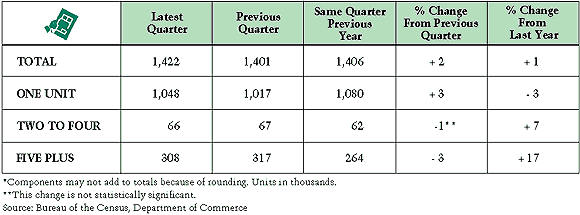
 Starts* Starts*
Construction starts of new housing units in the first quarter of 1997
totalled 1,441,000 units at a seasonally adjusted annual rate, 2 percent
above the fourth quarter of 1996, but 2 percent below the first quarter
of 1996. Both these changes are statistically insignificant. Single-family
starts, at 1,153,000 units, were 6 percent higher than the previous quarter
but a statistically insignificant 1 percent below the 1996 rate. Multifamily
starts
totalled 248,000 units, a statistically insignificant 3 percent above the
previous quarter but 11 percent below
the same quarter in 1996.
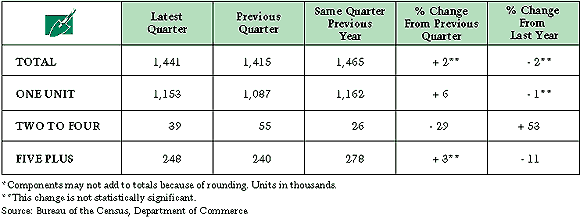
 Under Construction* Under Construction*
Housing units under construction at the end of the first quarter of
1997 were at a seasonally adjusted annual rate of 819,000 units, even with
the previous quarter and the first quarter of 1996. Single-family units
under construction at the end of the first quarter of 1997 stood at 572,000
units, even with the previous quarter but a statistically insignificant
2 percent below the first quarter of 1996. Multifamily units were at 219,000
units, up a statistically insignificant 1 percent from the previous quarter
and up a statistically insignificant 2 percent the first quarter of 1996.
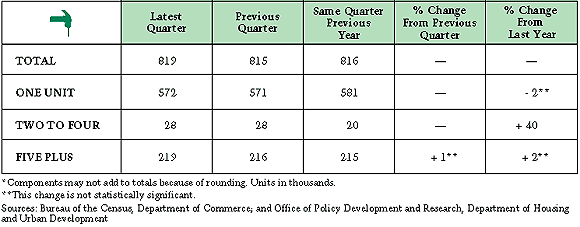
 Completions* Completions*
Housing units completed in the first quarter of 1997 at a seasonally
adjusted annual rate of 1,442,000 units were up a statistically insignificant
1 percent from the previous quarter and up a statistically insignificant
5 percent above the same quarter of 1996. Single-family completions, at
1,158,000 units, were unchanged
from the previous quarter and a statistically insignificant 6 percent above
the rate of a year earlier. Multi-
family completions, at 247,000 units, were a statistically insignificant
3 percent above the previous quarter
and 8 percent above the same quarter of 1996.
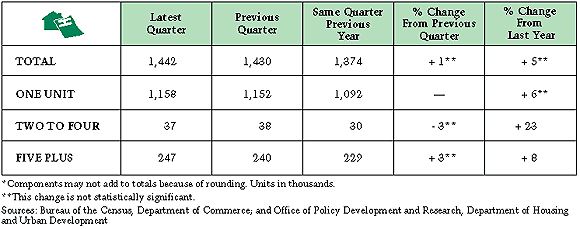
 Manufactured (Mobile) Home Shipments* Manufactured (Mobile) Home Shipments*
Shipments of new manufactured (mobile) homes to dealers were at a seasonally
adjusted annual rate of 349,000 units in the fourth quarter of 1996, which
is 5 percent below the previous quarter and 3 percent below the rate of
a year earlier.

HOUSING MARKETING
 Home Sales* Home Sales*
Sales of new single-family homes totalled 824,000 units at a seasonally
adjusted annual rate (SAAR) in the
first quarter of 1997, 8 percent above the previous quarter and 12 percent
above the first quarter of 1996. The number of new homes for sale at the
end of March 1997 numbered 297,000 units, down 8 percent from the
last quarter and down 19 percent from the first quarter of 1996. At the
end of March, inventories represented
a 4.5 months' supply at the current sales rates, down 10 percent from the
previous quarter and down 27 percent from the first quarter of 1996.
Sales of existing single-family homes reported by the NATIONAL ASSOCIATION
OF REALTORS®, for the first quarter of 1996 totalled 4,083,000
(SAAR), up 2 percent from the fourth quarter's level and up 3 percent from
the first quarter of 1996. The number of units for sale at the end of the
first quarter was 2,350,000, which is 52 percent above the previous quarter
but only 4 percent above the first quarter of 1996. At the end of the first
quarter, there was a 6.9 months' supply of units, 44 percent above the
previous quarter but only 6 percent above the first quarter of 1996.
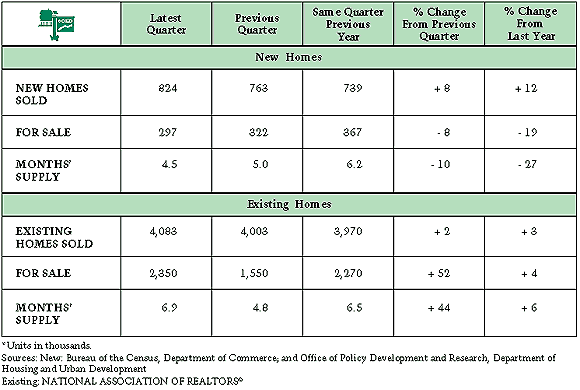
 Home Prices Home Prices
The median price of new homes during the first quarter of 1996 was $143,000,
down a statistically insignificant 1 percent from the previous quarter's
level and up a statistically insignificant 4 percent from the first quarter
of 1996. The average price of new homes sold during the first quarter of
1996 was $170,800, equal to the average price in the third quarter of 1996
and up 6 percent from the same quarter a year ago. The price adjusted to
represent a constant-quality house was $168,000, a statistically insignificant
2 percent above both the third quarter of 1996 and the first quarter of
1996. The values for the set of physical characteristics used
for the constant-quality house are based on 1992 sales.
The median price of existing single-family homes in the first quarter
of 1996 was $119,400, which is 2 percent above last quarter and 4 percent
above the first quarter of 1996, according to the NATIONAL ASSOCIATION
OF REALTORS®. The average price of $147,300 was 2 percent
above the previous quarter and 5 percent above the first quarter of 1996.
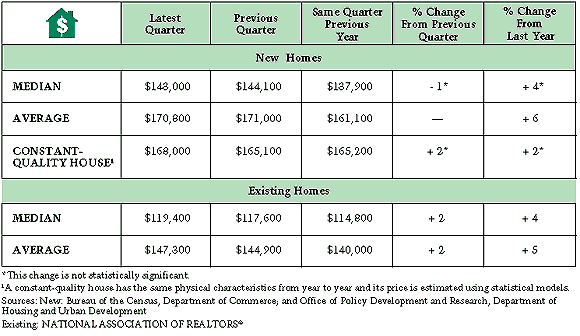
 Housing Affordability Housing Affordability
Housing affordability is the ratio of median family income to the income
needed to purchase the median-priced home based on current interest rates
and underwriting standards, expressed as an index. The NATIONAL ASSOCIATION
OF REALTORS® composite index value for the first quarter
of 1997 shows that families earning the median income have 130.4 percent
of the income needed to purchase the median-priced existing home. This
figure is 1 percent below the fourth quarter of 1996 and 2 percent below
the first quarter of 1996. This decrease is the result of a 2-percent increase
in the median home price and a 1-basis-point increase in the interest rate
offsetting a 1-percent rise in median family income during the last quarter.
The fixed-rate index was unchanged from the fourth quarter of 1996 but
fell by 4 percent from the first quarter of 1996. The adjustable-rate index
decreased by 1 percent from the previous quarter but increased by 1 percent
from the same quarter a year earlier.

 Apartment Absorptions Apartment Absorptions
There were 43,400 new, unsubsidized, unfurnished, multifamily (5 or
more units in structure) rental apartments completed in the fourth quarter
of 1996, down 19 percent from the previous quarter and down a statistically
insignificant 5 percent from the fourth quarter of 1995. Of the apartments
completed in 1996's fourth quarter, 72 percent were rented within 3 months.
This absorption rate is a statistically insignificant 1 percent above the
previous quarter but a statistically insignificant 5 percent below the
same quarter the previous year. The median asking rent for apartments completed
in the fourth quarter was $690, which is a statistically insignificant
1 percent above the previous quarter and a statistically insignificant
2 percent higher than a year earlier.
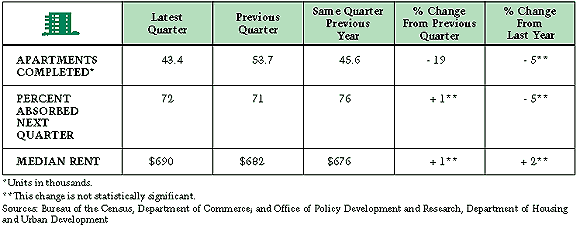
 Manufactured (Mobile) Home Placements Manufactured (Mobile) Home Placements
Manufactured homes placed on site ready for occupancy in the fourth
quarter of 1996 totalled 332,000 at a seasonally adjusted annual rate,
7 percent above the level of the previous quarter and 8 percent above the
fourth quarter of 1995. The number of homes for sale on dealers' lots at
the end of the fourth quarter totalled 112,000 units, a statistically insignificant
1 percent below the previous quarter but 22 percent above the same quarter
of 1995. The average sales price of the units sold in the fourth quarter
was $39,200, unchanged from the previous quarter and a statistically insignificant
2 percent higher than the 1995 price.
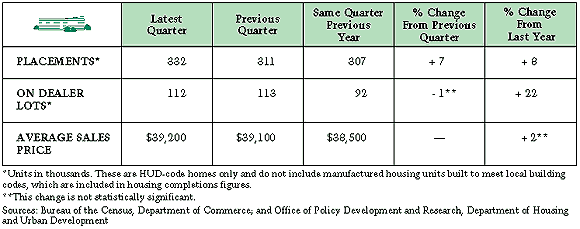
 Builders' Views of Housing Market Activity Builders' Views of Housing Market Activity
The National Association of Home Builders (NAHB) conducts a monthly
survey focusing on builders' views
of the level of sales activity and their expectations for the near future.
NAHB uses these survey responses to construct indices of housing market
activity. (The index values range from 0 to 100.) The 1997 first-quarter
value for the index of current market activity for single-family detached
houses stood at 57, unchanged from the fourth quarter and from 1996's first
quarter. The index for future sales expectations, 66, was up 5 points from
the fourth-quarter value and up 4 points from 1996's level. Prospective
buyer traffic had an index value
of 45, which is 4 points above the fourth-quarter value and 3 points above
1996's first-quarter level. NAHB combines these separate indices into a
single housing market index that mirrors the three components quite closely.
In the first quarter, this index stood at 55, which is 2 points above the
fourth-quarter level and 1 point above the value from 1996.
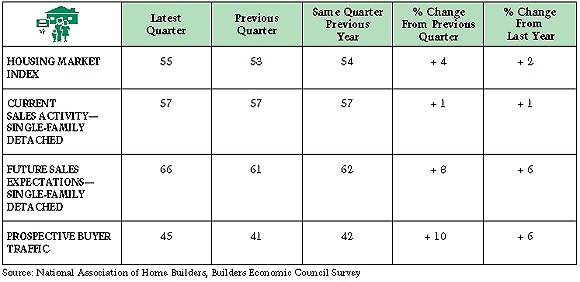
HOUSING
FINANCE
 Mortgage Interest Rates Mortgage Interest Rates
Mortgage interest rates for all categories of loans changed little from
the previous quarter. The contract mortgage interest rate for 30-year,
fixed-rate, conventional mortgages reported by Freddie Mac was 7.79 percent
in the first quarter, 10 basis points higher than the previous quarter
but 51 basis points higher than the same quarter of 1996. Adjustable-rate
mortgages in the first quarter were going for 5.56 percent, the same as
in the previous quarter and 23 basis points above the same quarter of 1996.
Fixed-rate, 15-year mortgages, at 7.29 percent, were up 9 basis points
from last quarter and up 51 basis points from the same quarter of the previous
year. The FHA rate fell
3 basis points during the quarter and was 61 basis points above the same
quarter in 1996. It should be noted that we are now reporting the average
interest rate quote for the FHA series rather than the most active quote.
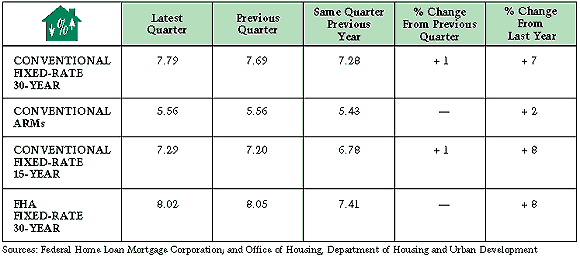
 FHA 14 Family Mortgage Insurance* FHA 14 Family Mortgage Insurance*
Applications for FHA mortgage insurance on 14 family homes were
received for 245,700 (not seasonally
adjusted) properties in the first quarter of 1997, up 11 percent from the
previous quarter but down 22 percent from the first quarter of 1996. Endorsements
or insurance policies issued totalled 199,700, down 5 percent from the
fourth quarter of 1996 and down 3 percent from the first quarter of 1996.
Endorsements for refinancing were 24,100, up 33 percent from the fourth
quarter of 1996, but down 40 percent from a year earlier.
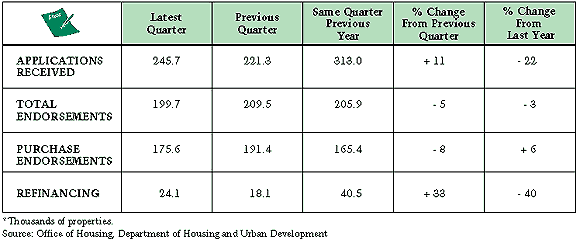
 PMI and VA Activity* PMI and VA Activity*
Private mortgage insurers issued 205,000 policies or certificates of
insurance on conventional mortgage loans during the first quarter of 1997,
down 15 percent from the fourth quarter and down 16 percent from the first
quarter of 1996; these numbers are not seasonally adjusted. The U.S. Department
of Veterans Affairs reported
the issuance of mortgage loan guaranties for 63,600 single-family properties
in the first quarter of 1997, down
7 percent from the previous quarter and down 27 percent from the first
quarter of 1996.

 Mortgage Originations by Loan Type, 14 Family Units Mortgage Originations by Loan Type, 14 Family Units
The total value of mortgage originations for 14 family homes was
$190.9 billion in the fourth quarter of 1996, unchanged from the third
quarter of 1996. Uninsured mortgage volume grew 5 percent; FHA-insured
mortgages decreased 5 percent; VA-guarantied mortgages decreased by 12
percent; and privately insured mortgages decreased 15 percent. The overall
increase from the fourth quarter of 1995 was 1 percent. FHA mortgage volume
increased 31 percent and VA-guarantied mortgages increased 4 percent while
the volume of uninsured mortgages decreased 1 percent, and privately insured
mortgages decreased 7 percent. Market shares changed
to reflect changes in volumes during the fourth quarter of 1996 and the
fourth quarter of 1995; however, the changes never exceeded 3 percentage
points.
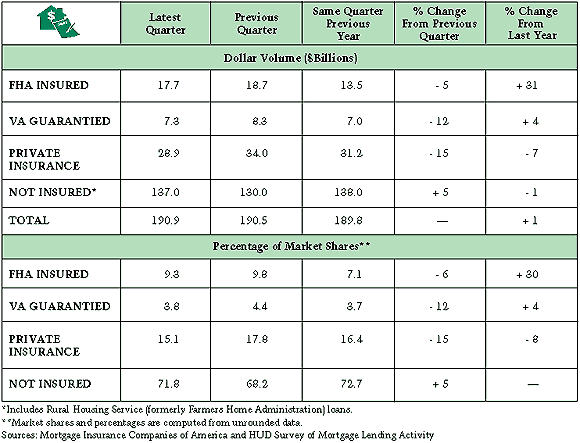
 Residential Mortgage Originations by Building Type* Residential Mortgage Originations by Building Type*
Residential mortgage originations totalled $203 billion in the fourth
quarter of 1996, up 1 percent from both the third quarter of 1996 and the
fourth quarter of 1995, and nearly identical to the single-family mortgage
pattern. The financing volume for multifamily (5+) units totalled $12.2
billion in the fourth quarter, up 16 percent from the previous quarter
and 6 percent from the fourth quarter of 1995.

 Mortgage Originations by Lender Type, 14 Family Units Mortgage Originations by Lender Type, 14 Family Units
During the fourth quarter of 1996, commercial banks with a volume of
$47.1 billion and a market share of 24.7 percent showed a 12-percent increase
from the third quarter of 1996 and a 2-percent increase the fourth quarter
of 1995. Lenders in the other categories posted declines for the fourth
quarter: Mutual savings banks with a volume of $8 billion and a market
share of 4.2 percent declined 20 percent. Savings and Loans with a volume
of $27.9 billion and a market share of 14.6 percent declined 8 percent;
and other lenders declined 43 percent from a very small volume and market
share. Mortgage companies with the largest volume, $107 billion, and highest
market share, 56.1 percent, had no change from the previous quarter. However,
third and fourth quarter data
are based on a newly introduced sample design that calls into question
any comparisons of current data with
earlier data. More data from the newly introduced sample design needs to
be collected before the series can
be used with confidence for time-to-time comparisons. Volume data for other
lender types are unaffected;
however, comparisons of their market share data across time are affected
by this question of comparability.
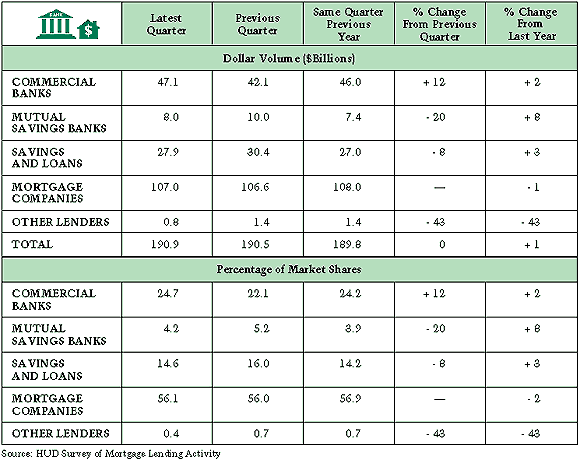
 Delinquencies and Foreclosures Delinquencies and Foreclosures
Total delinquencies were at 4.37 percent at the end of 1996's fourth
quarter, 5 percent above the third quarter, but 3 percent below the fourth
quarter of 1995. Ninety-day delinquencies were at 0.62 percent, also up
5 percent from the third quarter of 1996, but down 13 percent from the
fourth quarter of 1995. During the fourth quarter of 1996, 0.33 percent
of loans entered foreclosures, the same as in both the previous quarter
and the fourth quarter of 1995.
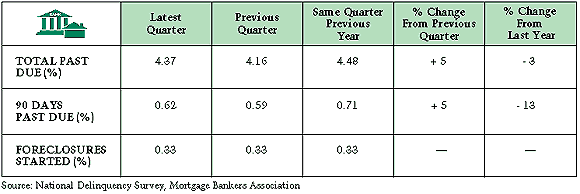
HOUSING
INVESTMENT
 Residential Fixed Investment and Gross Domestic Product* Residential Fixed Investment and Gross Domestic Product*
Residential Fixed Investment (RFI) for the first quarter of 1997 was
$318.5 billion, 2 percent above the value from the fourth quarter of 1996
and up 6 percent from the first quarter of 1996. As a percentage of the
Gross
Domestic Product, RFI was 4.1 percent, up 0.1 percentage point from the
previous quarter but equal to the value from a year ago.

HOUSING
INVENTORY
 Housing Stock* Housing Stock*
As of the first quarter of 1997, the estimate of the total housing stock,
115,064,000 units, was a statistically insignificant 0.4 percent above
the level of the fourth quarter of 1996 and 1.6 percent above 1996's first
quarter level. The number of occupied units was up a statistically insignificant
0.4 percent from last quarter and was 1.2 percent above the same quarter
in 1996. Owner-occupied homes were a statistically insignificant 0.3 percent
above the level of the fourth quarter of 1996 and 1.6 percent above the
first quarter of 1996. Rentals
increased a statistically insignificant 0.6 percent from last quarter and
increased a statistically insignificant
0.5 percent from the first quarter of 1996. Vacant units rose a statistically
insignificant 0.5 percent from last quarter and 4.5 percent from 1996.
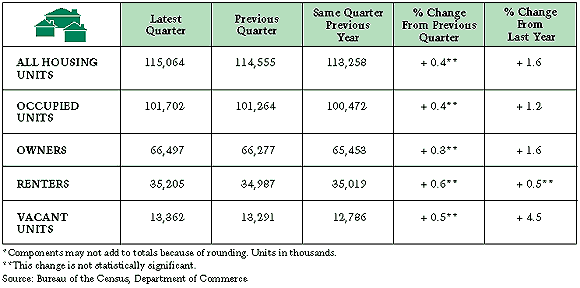
 Vacancy Rates Vacancy Rates
The 1997 first-quarter national rental vacancy rate, at 7.5 percent,
was down a statistically insignificant
0.2 percentage point from last quarter and down 0.4 percentage point from
the level of the first quarter of
1996. The homeowner vacancy rate, at 1.7 percent, was unchanged from last
quarter but up a statistically
insignificant 0.1 percentage point from the first quarter of 1996.

 Homeownership Rates Homeownership Rates
The national homeownership rate was 65.4 percent in the first quarter
of 1997, equal to the rate from the last quarter but up 0.3 percentage
point from the first quarter of 1996. The homeownership rate for minority
households increased a statistically insignificant 0.3 percentage point
from the fourth quarter and increased
1.0 percentage point from the first quarter of 1996. The rate for young
households of 58.1-percent homeownership was up a statistically insignificant
0.1 percentage point from last quarter's rate and a statistically
insignificant 0.4 percentage point from 1996's first quarter.
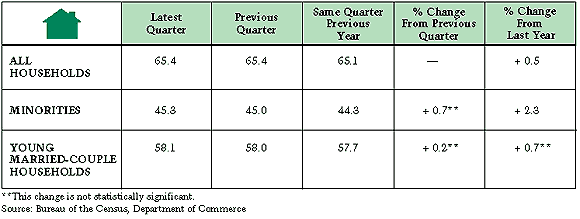
|

